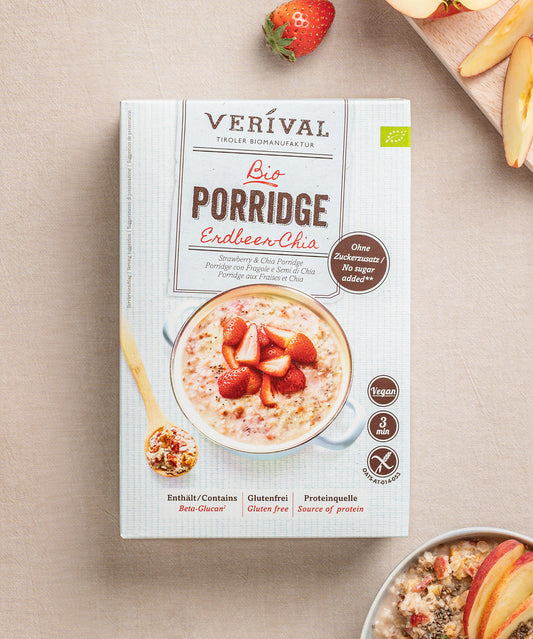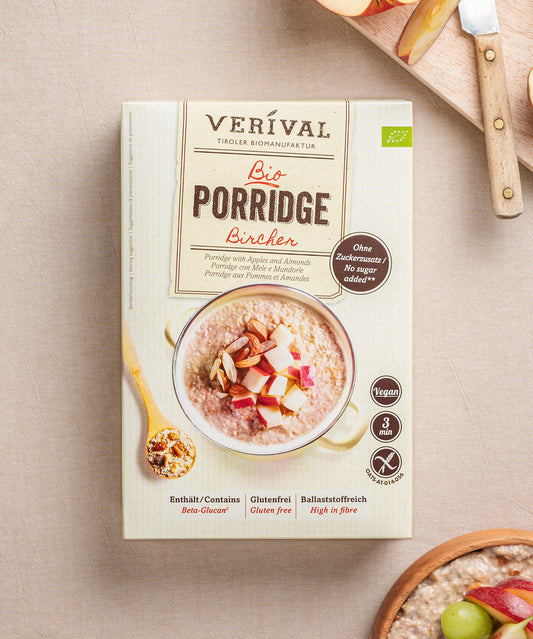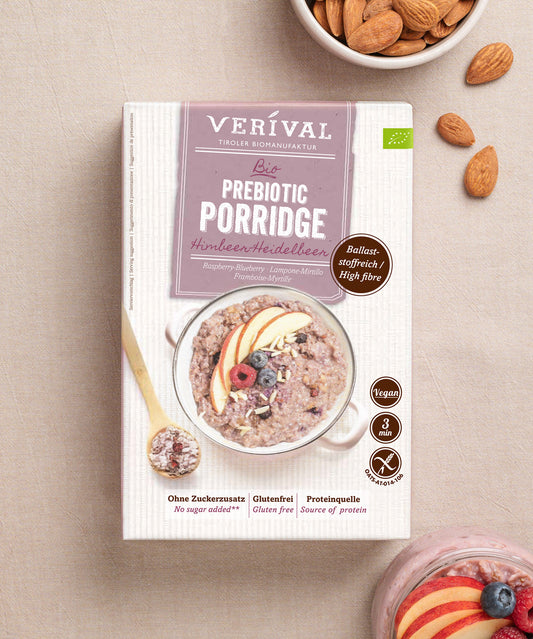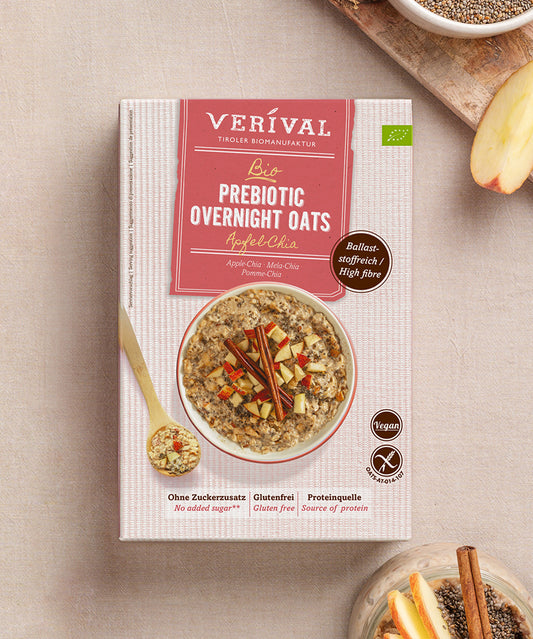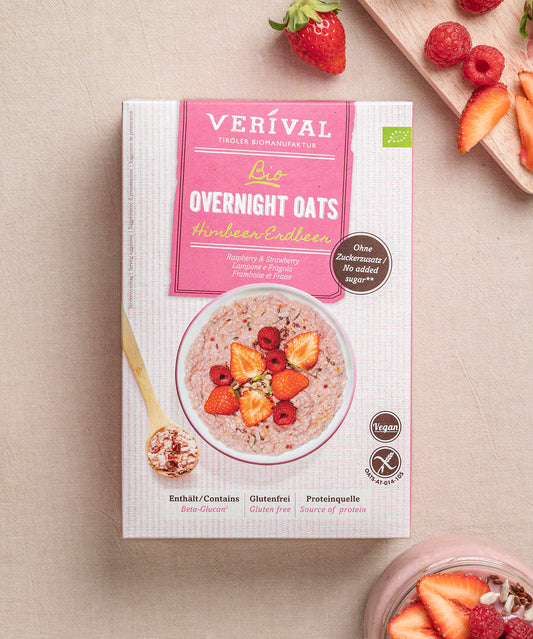Apples are not only delicious, but also known for their health benefits. One of their outstanding aspects is their high fiber content. These small, crunchy fruits are rich in essential nutrients and contribute significantly to our daily fiber intake. But how much fiber is actually in an apple?
Discover delicious Verival Porridge here!
Origin of the apple
The history of the apple goes back thousands of years and is closely linked to the history of mankind. The origins of the apple tree probably lie in Central Asia, where wild apple species such as Malus sieversii grew.
Cultivation and growing
The cultivation of apples began several thousand years ago. The ancient Greeks and Romans played an important role in spreading apple varieties throughout Europe. The Romans developed various cultivation methods and crossed different varieties to breed new and tastier apples.
Apples throughout history
Apples have had symbolic significance in many cultures. They were associated with fertility, love and knowledge. In Norse mythology, the apple was a symbol of immortality. In the Bible, the apple is often mentioned as the fruit of knowledge in connection with the Garden of Eden.
Fibers in apple varieties: not all apples are the same
Old varieties
Some of the oldest known apple varieties are, for example, the “Cox Orange Pippin” from England or the “Reinette von Blenheim” from France. These varieties have a rich history and are still popular today due to their flavor and shelf life.
Modern varieties
Over time, many new apple varieties have been bred to suit different tastes and preferences. Examples of modern varieties include the sweet and juicy Honeycrisp, the crisp Gala, and the tart Granny Smith.
Apple growing today
Today, apples are grown in many parts of the world, from Europe to North America to Asia and Australia. Modern growing techniques and storage facilities have made it possible for us to have access to a wide variety of apples throughout the year.
Variety of uses
Apples are not only popular as fresh fruit, but can also be found in a wide variety of foods and drinks. From apple sauce to apple pie to cider and apple juice – the range of uses is enormous.
The history of the apple is a fascinating journey through time, closely linked to the history of mankind. From ancient times to modern breeding and uses, the apple has played a prominent role in culture, symbolism and nutrition. The wide variety of apple types and their availability make them one of the most popular and versatile fruits worldwide.
Find out everything you need to know about high-fiber breakfast here.
The importance of fiber in apples
Not all dietary fibers are the same – they can be divided into different types, each of which offers different health benefits.
Soluble dietary fiber
Soluble dietary fiber dissolves in water to form a gel-like substance. They can help lower cholesterol levels by reducing the absorption of dietary cholesterol in the intestines. They also help stabilize blood sugar levels by slowing its rise after meals. Foods such as oats, barley, legumes, apples and citrus fruits are rich in soluble fiber.
Insoluble fiber
Unlike soluble fiber, insoluble fiber does not dissolve in water. It increases stool volume and promotes gut health by preventing constipation and supporting bowel movement. Whole grains, vegetables, nuts, and seeds are good sources of insoluble fiber.
Prebiotic fiber
Prebiotic fiber feeds the healthy bacteria in the gut, such as bifido- and lactobacilli. It promotes the growth of these beneficial bacteria and thus supports a healthy intestinal flora. Foods such as onions, garlic, artichokes and bananas contain prebiotic fiber.
Resistant starch
Resistant starch is a type of dietary fiber that is not fully digested in the small intestine. It passes into the large intestine, where it is fermented by the resident bacteria. Resistant starch can promote gut health and regulate blood sugar levels. Foods such as green bananas, legumes and cold rice contain resistant starch.
The variety of dietary fiber offers a wide range of health benefits. By including a variety of high-fiber foods in your diet, you can benefit from the different types of fiber, thereby improving digestive health, stabilizing blood sugar levels and promoting a healthy intestinal flora. A balanced diet rich in different sources of fiber is key to optimal health.
Dietary fiber is an essential part of our diet that offers a wide range of health benefits. Its influence on digestion, metabolic regulation and cardiovascular health makes it an important element of a balanced diet.
Dietary fiber makes apples particularly healthy
Aids digestion
Dietary fiber plays a crucial role in supporting healthy digestion. Insoluble fiber, found in foods such as whole grains, vegetables, and fruits, increases stool volume and speeds passage through the digestive tract. This helps prevent constipation and other digestive issues.
Blood sugar regulation
Another important aspect of dietary fiber is its ability to regulate blood sugar levels. Soluble fiber, found in foods such as legumes, oats and some fruits, can help slow the rise in blood sugar levels after a meal. This supports a more stable energy supply and reduces the risk of insulin resistance and type 2 diabetes.
Heart health
Apple fiber also plays an important role in maintaining heart health. It can help lower cholesterol levels, especially LDL cholesterol (“bad” cholesterol), which can reduce the risk of heart disease. It does this by reducing the absorption of dietary cholesterol and promoting its excretion.
Satiety and weight management
Fiber can also help with weight management and losing weight by promoting a feeling of satiety. Foods high in fiber take longer to digest and can help control hunger over a longer period of time, which in turn can lead to fewer calories being consumed. This makes the apple, as a low-calorie food, perfect for your diet.
The importance of fiber for health is undeniable. A diet high in fiber can help improve digestive health, regulate blood sugar levels, support heart health, and aid in weight management. The recommendation to consume an adequate amount of fiber daily from a variety of sources is an essential part of a healthy lifestyle.
With this understanding of the importance of fiber, it is clear why eating high-fiber foods like apples is a smart choice for a healthy diet.
Where is fiber found in apples?
Apples are one of the most popular fruits worldwide and are not only known for their refreshing taste, but also for their remarkable nutritional value, especially their fiber content. It is the fiber in apples that makes them so healthy.
Fiber in the apple skin
A significant portion of the fiber in apples is found in their skin. This thin, often-underrated outer layer is high in insoluble fiber, which aids in digestion. Therefore, when you eat an apple with its skin on, you benefit from a majority of the fiber this fruit has to offer.
Fiber variability by apple variety
Although apples are generally high in fiber, different apple varieties may have slightly different amounts. Tart varieties like Granny Smith tend to have slightly more fiber than sweeter varieties like Gala or Red Delicious. However, the difference in fiber content between the different varieties is small and should not be the main factor when choosing an apple.
Fiber in apples and its changes during processing
During the processing of apples, for example when juicing or cooking, the fiber content can change slightly. Juicing apples removes the peel and thus a considerable part of the apple fiber. So if you want to benefit from the fiber, it is advisable to eat or use the apple with the peel.
Maximizing the fiber content of apples
To get the maximum benefit from the fiber in an apple, you should try to keep the peel and eat it naturally. However, even if the peel is removed, a significant amount of the fiber remains in the flesh, so apples are still a good source of fiber even without the peel.
Apples are not only delicious, but also an excellent source of dietary fiber. With a large proportion of these valuable nutrients in their peel, they offer an easy way to increase your daily fiber intake. The wide variety of apples allows you to take your personal taste into account without sacrificing the fiber benefits. So whether you eat them with the peel or without, apples are a fantastic choice for a healthy diet that provides you with sufficient fiber.
Lose weight while having breakfast? It's that easy!
The benefits of eating apple fiber
There are a variety of health benefits to be gained from regularly eating apples, especially with their peel. That's because the fiber in these fruits plays an important role in promoting digestion, controlling blood sugar and maintaining healthy heart function. An apple a day can not only keep the doctor away, but also help promote optimal health.
Apple fiber for improved digestion
The fiber in apples is crucial for healthy digestion. It promotes intestinal health, regulates intestinal movement and prevents constipation. By supporting digestion, it helps the body to absorb nutrients efficiently.
Control blood sugar with apple fiber
Consuming apple fiber can help stabilize blood sugar levels. The fiber contained in apples slows the absorption of sugar into the blood, thus helping to avoid sudden blood sugar spikes. This can help control hunger and reduce the risk of diabetes.
Heart health through apples
The fiber in apples also contributes to heart health by helping to lower cholesterol levels. Lower cholesterol reduces the risk of heart disease and supports the cardiovascular system.
While apples are a great source of fiber, it is important to note that a balanced diet requires a variety of food sources. Consuming a variety of high-fiber foods, such as vegetables, whole grains, and legumes, is important to benefit from the different types of fiber and their specific benefits.
Dietary fiber in apples: a conclusion
Apples are an excellent natural source of dietary fiber. With an average of about 4.4 grams of fiber per apple, they contribute significantly to daily fiber intake. The dietary fiber contained in apples offers numerous health benefits, including improved digestion, blood sugar control and heart health. However, a diverse diet that includes a variety of high-fiber foods is recommended to get all the benefits of different sources of fiber.
So, the next time you bite into a crisp apple, remember that you're not only enjoying a tasty snack, but also giving your body a boost of valuable fiber.
Frequently asked questions
How much fiber is in an apple?
The average apple contains about 4.4 grams of fiber, with most of it found in the peel.
What are the health benefits of eating apples?
Eating apples can help promote digestive health, regulate blood sugar, support heart health, and provide essential vitamins and antioxidants.
What is the maximum amount of fiber you should consume per day?
The recommended daily fiber intake is about 25 grams for women and 38 grams for men.
Why are apples so healthy?
Apples contain a variety of nutrients, including fiber, vitamins, and antioxidants, that may promote health and reduce the risk of disease.
Can you lose weight with apples?
Apples are a good option for a low-calorie, healthy diet due to their fiber content and their ability to create a feeling of satiety, which can contribute to weight loss.
Is the apple diet effective?
The apple diet is a method that can help you lose weight. However, a diet based solely on apples can lead to an unbalanced nutrient intake and is therefore not recommended. A varied, balanced diet is more effective for your health.
Are apples healthy?
Yes, apples are healthy because of their nutrient content, fiber and antioxidants, which can boost immune function and prevent cardiovascular disease.
Why is fiber important for the body?
Fiber aids digestion, regulates blood sugar levels, reduces the risk of heart disease and contributes to satiety, making it an important part of a healthy diet.


